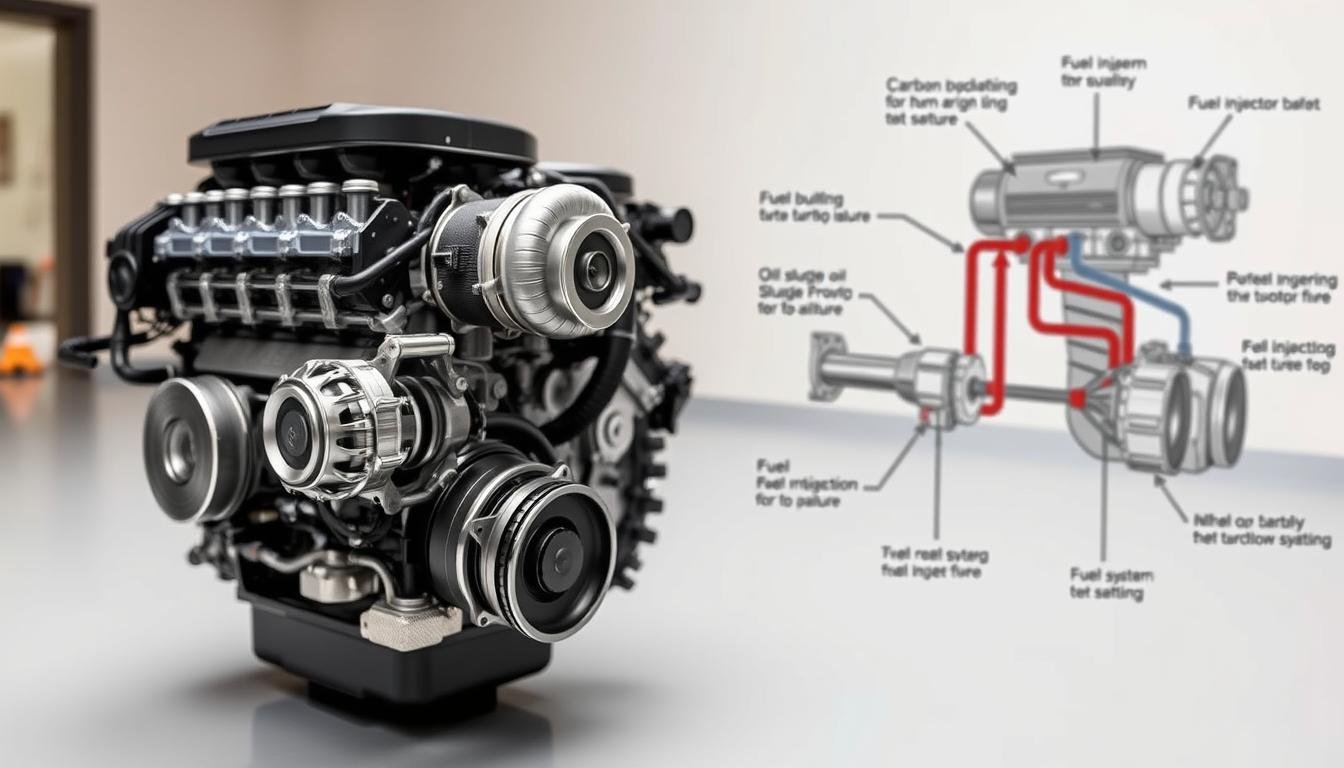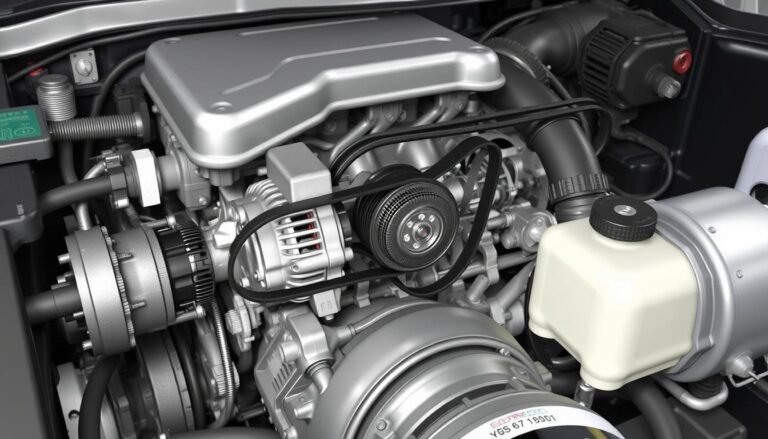Common Ford 2.7 EcoBoost Engine Issues & Fixes
The Ford 2.7 EcoBoost engine mixes efficiency with performance. Yet, it may run into issues over time.
These problems include carbon build-up, oil pan leaks, and failures in ignition coils, spark plugs, and head gaskets, along with using too much oil.
Spotting these troubles early can prevent expensive fixes and keep your engine running well. You’ll get valuable info on fixing common Ford 2.7 EcoBoost engine issues here.
Learn how to recognize signs of these problems and find effective solutions. We cover everything from fixing carbon build-up to repairing oil leaks and spark plug issues.
This guide empowers you to manage your vehicle’s upkeep, ensuring a smooth drive for the future.
Overview of Ford 2.7 EcoBoost Engine
The Ford 2.7 EcoBoost engine is a turbocharged V6. It balances power with fuel efficiency perfectly.
Eco-boost technology boosts performance, improving fuel economy without losing power. It uses direct injection to enhance combustion.
This means it gets more power from less fuel compared to older engines. This engine has a 2.7 liter size.
It can produce about 325 horsepower and 400 lb-ft of torque. Whether you’re commuting or doing heavy-duty work, it handles it well.
The turbocharging increases power while using less fuel. Truck and SUV fans love it for its reliability and strength.
| Engine Feature | Details |
|---|---|
| Engine Type | Turbocharged V6 |
| Displacement | 2.7 liters |
| Horsepower | Approximately 325 hp |
| Torque | 400 lb-ft |
| Technology | Eco-boost technology with direct injection |
| Fuel Efficiency | Optimized for lower fuel consumption |
Common Ford 2.7 EcoBoost Problems
The Ford 2.7 EcoBoost engine offers great power and efficiency. However, it does have some common issues that can affect its reliability.
Knowing about these problems can help you take care of your car better and avoid expensive fixes.
What is The Key Issues?
Some common issues with the 2.7 EcoBoost engine are:
- Carbon build-up in the intake system
- Oil pan leaks leading to loss of oil
- Failures in ignition coils and spark plugs
- Head gasket failures that can damage the engine
- Using too much oil, affecting how the engine works
It’s important to know about these problems. Early signs can help catch issues before they get worse. This way, you can keep your engine running well.
Importance of Early Detection
Finding problems early means you can fix them sooner. For instance, if your car hesitates when speeding up, it might be an ignition issue.
Seeing oil on the ground under your car could mean a leak. Acting quickly not only saves money but also helps your engine last longer.
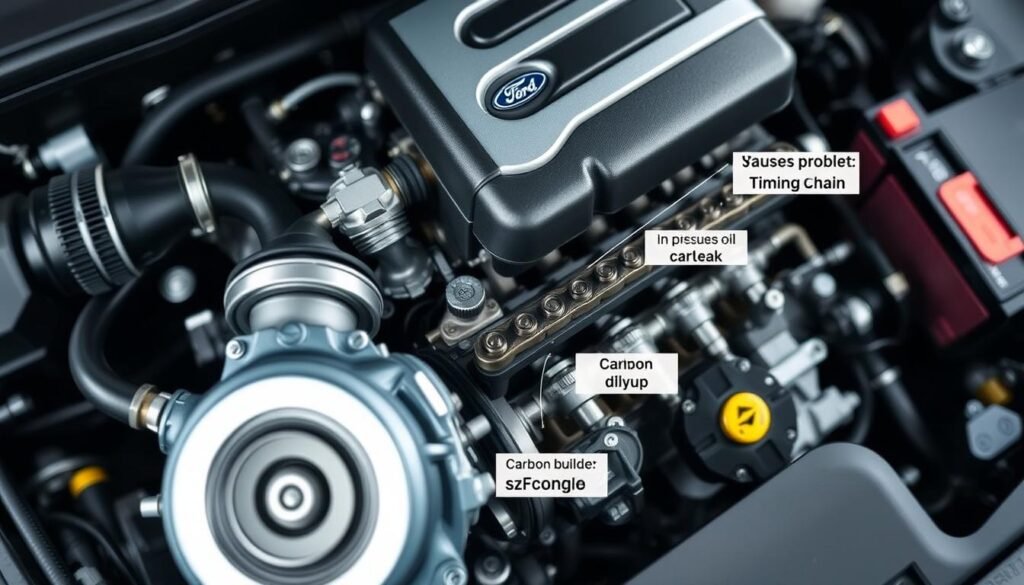
Carbon Build-Up: Causes and Solutions
Carbon build-up has a big impact on how well an engine performs. This is especially true for the Ford 2.7 EcoBoost.
Knowing why carbon build-up happens is key to solving the issue early. We will explore what causes carbon build-up, signs to watch for, and how to fix it to get your engine running well again.
What is Carbon Build-Up?
Carbon build-up means carbon deposits gather on parts inside the engine, like the intake valves. It usually starts because of the direct injection system.
This system puts fuel directly into the combustion chamber. Oil blow-by and incomplete combustion also add to the problem, causing different issues with how the engine works.
Symptoms of Carbon Build-Up
It’s important to spot the signs of carbon build-up early. This stops bigger problems with your engine. You might notice:
- Engine misfires
- Rough idling
- Loss of power when speeding up
- Stuttering and hesitation while on the move
Effective Fixes For Carbon Build-Up
For fixing carbon build-up in the Ford 2.7 EcoBoost, try walnut blasting. It’s a clever cleaning method that gets rid of carbon deposits, making your engine run better.
Also, using top-quality fuel and regular maintenance helps prevent build-up later. Taking care of your engine’s needs is vital for its best performance.

Oil Pan Leaks: Identifying The Issue
Ford 2.7 EcoBoost owners, especially those with 2015 to 2017 models, often face oil pan leaks.
Knowing the causes, recognizing signs, and learning repair methods are key steps. This knowledge helps you tackle the issue effectively.
What Causes Oil Pan Leaks?
Oil pan leaks usually result from seals failing between the oil pan and engine block. The plastic oil pan in early models can warp, causing sealing problems.
Age, wear, and the environment can make it worse, leading to leaks.
Recognizing The Symptoms
Keeping an eye out for oil leak signs is vital for your vehicle’s health. Symptoms to watch for include:
- Low oil levels, needing frequent top-ups
- Visible oil spots or puddles under the vehicle
- Dashboard warning lights for low oil pressure
Repair Strategies For Oil Pan Leaks
Repairing oil leaks in the Ford 2.7 EcoBoost might mean replacing the oil pan or its gasket.
It’s important to use the right sealing methods to avoid future leaks. If unsure, it’s best to consult with a professional.
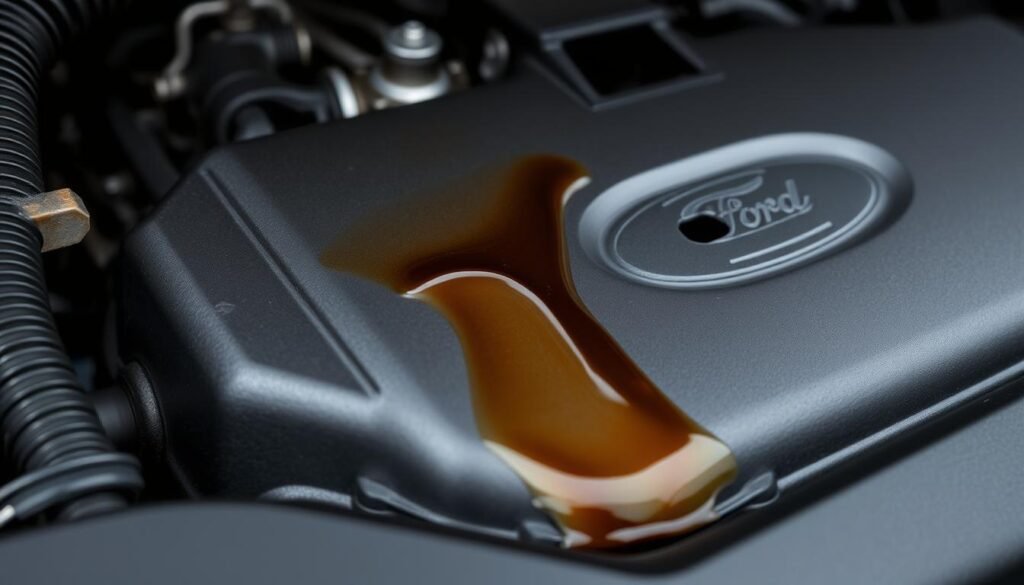
Ignition Coil and Spark Plug Failures
The Ford 2.7 EcoBoost engine needs strong ignition components because of its turbo design. High stress from this can break these parts early.
If things go wrong, the engine might misfire. This feels like roughness when the car idles or when trying to speed up.
Keeping up with regular checks helps avoid these issues. Follow the guide for when to get new spark plugs to lower the chance of coil problems.
Choosing top-quality parts makes them last longer and work better. Checking these parts often means problems can be found and fixed sooner.
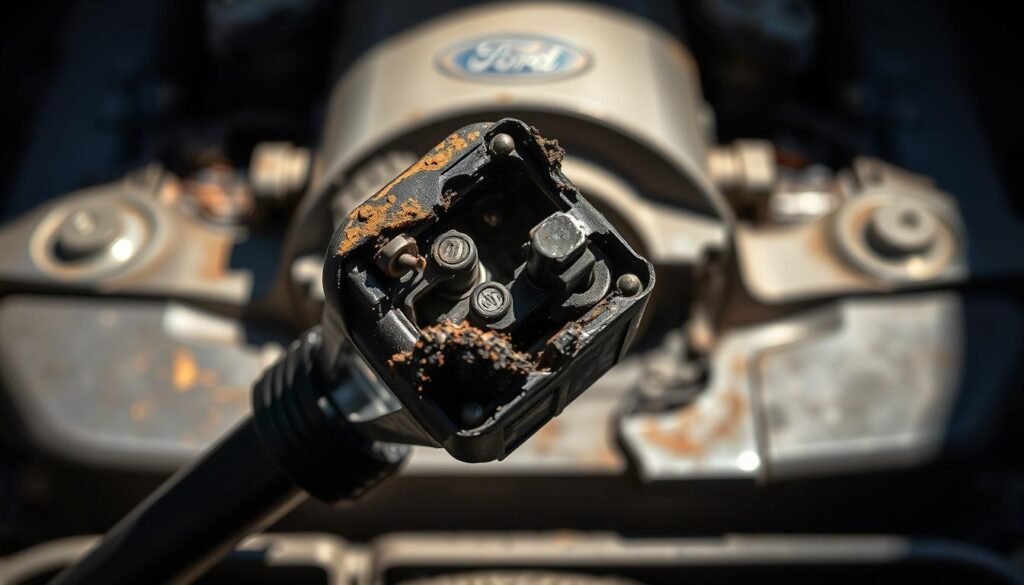
Head Gasket Failures in The 2.7 EcoBoost
The head gasket plays a crucial role in your Ford 2.7 EcoBoost engine. It keeps the engine block and cylinder head tightly sealed. This prevents coolant and engine oil from mixing.
As it deals with high stress, it’s common for head gaskets to fail. Knowing what problems could arise helps keep your engine running smoothly.
Learning Head Gasket Function
The head gasket seals the combustion chamber to ensure the engine runs well. It stops leaks and maintains correct pressure.
Since it faces intense heat and pressure, wear over time is inevitable. If it fails, this can lead to serious issues like engine overheating and damage to surrounding parts.
Signs of Head Gasket Failure
It’s crucial to know the early warning signs of head gasket failure. These include:
- Coolant leaks around the engine area
- White smoke from the exhaust
- Engine overheating
- Oil that looks milky
- Less engine power
Addressing these symptoms early can save you from bigger problems and expensive fixes.
Fixing Head Gasket Issues
Fixing a head gasket in a 2.7 EcoBoost engine often requires help from a pro. The steps usually involve:
- Taking out the damaged gasket
- Checking the cylinder head for issues
- Putting in a new gasket
- Reassembling the engine parts with care
To prevent gasket problems, regular check-ups are key. Watch your coolant levels and engine temperature. Doing so helps in spotting problems early and fixing them quickly.
Excessive Oil Consumption: What You Need To Know?
If your Ford 2.7 EcoBoost engine uses too much oil, it could be a sign of big problems.
Keeping an eye on your car helps keep it running well. Catching issues early can stop bigger damage and save you money on repairs.
Identifying Excessive Oil Consumption
To spot too much oil use, look for certain signs. Needing to add oil often means your engine is using more oil than it should.
Watch out for these hints too:
- Dark smoke coming from the exhaust
- Dashboard lights warning about oil problems
- Oil spots or leaks under your car
Common Causes of High Oil Consumption
Knowing why your car uses lots of oil is the first step to fixing it. Often, the issue is caused by:
- Piston rings that don’t seal right
- Broken valve seals that let oil leak into the engine
- A PCV system not moving oil properly
Solutions To Oil Consumption Issues
There are ways to deal with too much oil use:
- Change old piston rings and leaky valve seals
- Check the PCV system for problems and fix them
- Keep up with your car’s maintenance, like oil changes and checking oil levels
Ford 2.7 EcoBoost Recalls and Safety Notices
It’s crucial to keep up with any ford 2.7 ecoboost recalls for your safety and your vehicle’s wellbeing.
Recent alerts point out serious issues for about 100,000 vehicles with the 2.7 EcoBoost engine.
These problems include broken intake valves that could cause the engine to fail, needing fast action.
Compromise Recalls Related To The 2.7 EcoBoost
Recalls help protect people from dangers that vehicle issues might cause. The ford 2.7 ecoboost recalls focus on problems that impact how your car performs and its safety.
Staying alert to these recalls helps avoid risks and expensive fixes.
How To Check For Recalls on Your Vehicle?
Looking up recalls for your Ford is easy to do. You can check if there are any recalls by using your Vehicle Identification Number (VIN) on the NHTSA website.
Or, a visit to your local Ford dealer can give you the latest updates and necessary repairs to keep your car running well.
Maintenance Tips For The Ford 2.7 EcoBoost Engine
Taking good care of your Ford 2.7 EcoBoost engine ensures it lasts longer and performs well.
Using the right engine maintenance tips can lower the chance of problems later. It’s smart to follow official maintenance advice to prevent issues.
Essential Maintenance Practices
Keeping your engine in top shape means regular checks and being proactive. Here are important tips for your Ford 2.7 EcoBoost engine:
- Change the oil every 5,000 to 7,500 miles, choosing quality synthetic oil.
- Check and change air filters when needed, about every 15,000 to 30,000 miles.
- Look at spark plugs and coils often to ensure they work right.
- Watch out for fluid leaks and fix them quickly.
Recommended Service Intervals
Sticking to recommended service times keeps your vehicle running smoothly. Here’s a quick guide on when to do what:
| Service | Service Interval |
|---|---|
| Oil Change | 5,000 – 7,500 miles |
| Spark Plug Replacement | 60,000 – 100,000 miles |
| Air Filter Replacement | 15,000 – 30,000 miles |
| Fluid Check | Every 6 months |
By sticking to these tips and watching your car’s health, you’ll keep your Ford 2.7 EcoBoost engine in great shape and enjoy a better drive.
How To Troubleshoot Ford 2.7 EcoBoost Issues?
To fix Ford 2.7 EcoBoost issues, start by observing the car’s behavior. Keep an eye out for things like rough idling or a drop in power.
Next, use an OBD-II scanner to find any error codes which will show where the problem lies. These early steps will help you figure out and fix the engine problems.
Common Diagnostic Approaches
For finding engine issues, several methods are handy:
- Use an OBD-II scanner for check engine lights and error codes.
- Drive the car to check how the engine performs.
- Look at fluid levels and quality, especially oil and coolant.
- Listen for any strange sounds that could mean something’s wrong mechanically.
- Check spark plugs for wear or damage.
When To Seek Professional Help
Some Ford 2.7 EcoBoost problems might need an expert’s touch. Get a mechanic’s help if:
- You can’t figure out the issue on your own.
- The engine overheats a lot, which could mean a bigger problem.
- You think there might be head gasket leaks or failure.
- The check engine light doesn’t turn off after fixing obvious problems.
Conclusion
The Ford 2.7 EcoBoost engine stands out for its strength and fuel efficiency. However, it faces challenges like carbon deposits, oil leaks, and faulty ignition parts.
Knowing these problems helps you protect your engine’s power. It’s very important to keep your vehicle in good shape. It’s crucial to do regular checks and stay up-to-date with recalls and safety alerts.
By fixing problems early and keeping up with maintenance, you make your Ford 2.7 EcoBoost more reliable and long-lasting.
Taking good care of your engine makes a big difference. A well-maintained engine is always more trustworthy.
Keep these tips in mind. Then, you can enjoy your Ford 2.7 EcoBoost’s impressive performance for a long time.
FAQs
Q: What are the common issues reported with the Ford 2.7 EcoBoost engine?
A: The most frequent problems are carbon build-up and oil pan leaks. Other issues include ignition coil and spark plug failures. There are also head gasket issues and excessive oil consumption.
Q: How can I tell if my Ford 2.7 EcoBoost engine is experiencing carbon build-up?
A: Engine misfires and rough idling are signs of carbon build-up. You might also experience loss of power and stuttering during acceleration.
Q: What should I do if I notice an oil pan leak in my Ford 2.7 EcoBoost?
A: If you see low oil levels or oil spots, it’s crucial to check for a leaking oil pan gasket. You may need to replace it or the oil pan.
Q: How often should I replace the spark plugs on my Ford 2.7 EcoBoost?
A: You should replace spark plugs every 60,000 to 100,000 miles. This depends on how you drive.
Q: What are the signs of a failing head gasket in the Ford 2.7 EcoBoost?
A: Look out for coolant leaks and engine overheating. White smoke from the exhaust is another sign.
Q: How can I address excessive oil consumption in my engine?
A: To fix excessive oil consumption, you might need to replace worn piston rings or valve seals. Also, check the Positive Crankcase Ventilation (PCV) system.
Q: Where can I check for recalls related to my Ford 2.7 EcoBoost engine?
A: Check your Vehicle Identification Number (VIN) on the National Highway Traffic Safety Administration (NHTSA) website. Or, talk to your local Ford dealer.
Q: What maintenance tips should I follow for the Ford 2.7 EcoBoost engine?
A: Regular oil changes are important. So is checking ignition components and watching for fluid leaks. Use high-quality engine oil and fuel.

